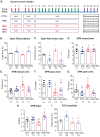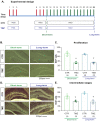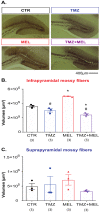Melatonin Prevents Depression but Not Anxiety-like Behavior Produced by the Chemotherapeutic Agent Temozolomide: Implication of Doublecortin Cells and Hilar Oligodendrocytes
- PMID: 37686181
- PMCID: PMC10487426
- DOI: 10.3390/ijms241713376
Melatonin Prevents Depression but Not Anxiety-like Behavior Produced by the Chemotherapeutic Agent Temozolomide: Implication of Doublecortin Cells and Hilar Oligodendrocytes
Abstract
Melatonin is a hormone synthesized by the pineal gland with neuroprotective and neurodevelopmental effects. Also, melatonin acts as an antidepressant by modulating the generation of new neurons in the dentate gyrus of the hippocampus. The positive effects of melatonin on behavior and neural development may suggest it is used for reverting stress but also for the alterations produced by chemotherapeutic drugs influencing behavior and brain plasticity. In this sense, temozolomide, an alkylating/anti-proliferating agent used in treating brain cancer, is associated with decreased cognitive functions and depression. We hypothesized that melatonin might prevent the effects of temozolomide on depression- and anxiety-like behavior by modulating some aspects of the neurogenic process in adult Balb/C mice. Mice were treated with temozolomide (25 mg/kg) for three days of two weeks, followed by melatonin (8 mg/kg) for fourteen days. Temozolomide produced short- and long-term decrements in cell proliferation (Ki67-positive cells: 54.89% and 53.38%, respectively) and intermediate stages of the neurogenic process (doublecortin-positive cells: 68.23% and 50.08%, respectively). However, melatonin prevented the long-term effects of temozolomide with the increased number of doublecortin-positive cells (47.21%) and the immunoreactivity of 2' 3'-Cyclic-nucleotide-3 phosphodiesterase (CNPase: 82.66%), an enzyme expressed by mature oligodendrocytes, in the hilar portion of the dentate gyrus. The effects of melatonin in the temozolomide group occurred with decreased immobility in the forced swim test (45.55%) but not anxiety-like behavior. Thus, our results suggest that melatonin prevents the harmful effects of temozolomide by modulating doublecortin cells, hilar oligodendrocytes, and depression-like behavior tested in the forced swim test. Our study could point out melatonin's beneficial effects for counteracting temozolomide's side effects.
Keywords: adult neurogenesis; anxiety; depression; hippocampus; melatonin; oligodendrocytes; temozolomide.
Conflict of interest statement
The authors declare no conflict of interest.
Figures







Similar articles
-
Melatonin Modulates Dendrite Maturation and Complexity in the Dorsal- and Ventral- Dentate Gyrus Concomitantly with Its Antidepressant-Like Effect in Male Balb/C Mice.Int J Mol Sci. 2020 Mar 3;21(5):1724. doi: 10.3390/ijms21051724. Int J Mol Sci. 2020. PMID: 32138332 Free PMC article.
-
Chronic administration of a melatonin membrane receptor antagonist, luzindole, affects hippocampal neurogenesis without changes in hopelessness-like behavior in adult mice.Neuropharmacology. 2016 Apr;103:211-21. doi: 10.1016/j.neuropharm.2015.11.030. Epub 2015 Dec 12. Neuropharmacology. 2016. PMID: 26686389
-
Melatonin pretreatment prevented the effect of dexamethasone negative alterations on behavior and hippocampal neurogenesis in the mouse brain.J Steroid Biochem Mol Biol. 2014 Sep;143:72-80. doi: 10.1016/j.jsbmb.2014.02.011. Epub 2014 Feb 28. J Steroid Biochem Mol Biol. 2014. PMID: 24589478
-
Benefits of the Neurogenic Potential of Melatonin for Treating Neurological and Neuropsychiatric Disorders.Int J Mol Sci. 2023 Mar 2;24(5):4803. doi: 10.3390/ijms24054803. Int J Mol Sci. 2023. PMID: 36902233 Free PMC article. Review.
-
Depression and adult neurogenesis: Positive effects of the antidepressant fluoxetine and of physical exercise.Brain Res Bull. 2018 Oct;143:181-193. doi: 10.1016/j.brainresbull.2018.09.002. Epub 2018 Sep 17. Brain Res Bull. 2018. PMID: 30236533 Review.
Cited by
-
Melatonin and carcinogenesis in mice: the 50th anniversary of relationships.Oncotarget. 2023 Dec 12;14:972-976. doi: 10.18632/oncotarget.28537. Oncotarget. 2023. PMID: 38085132 Free PMC article.
References
-
- Perry J.R., Bélanger K., Mason W.P., Fulton D., Kavan P., Easaw J., Shields C., Kirby S., Macdonald D.R., Eisenstat D.D., et al. Phase II trial of continuous dose-intense temozolomide in recurrent malignant glioma: RESCUE study. J. Clin. Oncol. 2010;28:2051–2057. doi: 10.1200/JCO.2009.26.5520. - DOI - PubMed
-
- Weller M., Tabatabai G., Kästner B., Felsberg J., Steinbach J.P., Wick A., Schnell O., Hau P., Herrlinger U., Sabel M.C., et al. MGMT Promoter Methylation Is a Strong Prognostic Biomarker for Benefit from Dose-Intensified Temozolomide Rechallenge in Progressive Glioblastoma: The DIRECTOR Trial. Clin. Cancer Res. 2015;21:2057–2064. doi: 10.1158/1078-0432.CCR-14-2737. - DOI - PubMed
-
- [(accessed on 3 July 2022)]. Available online: https://gco.iarc.fr/today/fact-sheets-cancers.
-
- [(accessed on 3 July 2022)]. Available online: https://www.cancer.net/cancer-types/brain-tumor/types-treatment.
MeSH terms
Substances
Grants and funding
LinkOut - more resources
Full Text Sources
Medical

